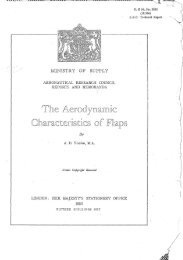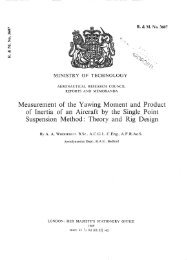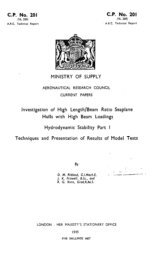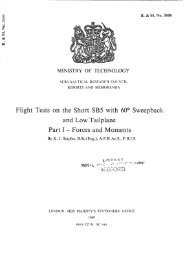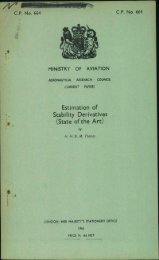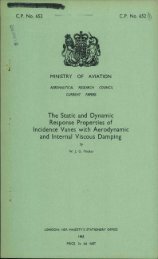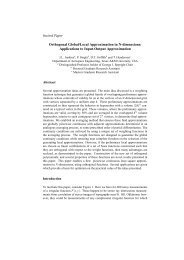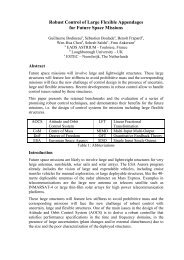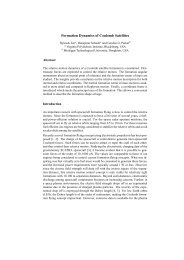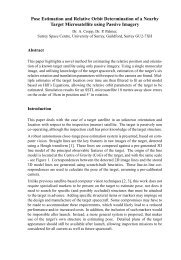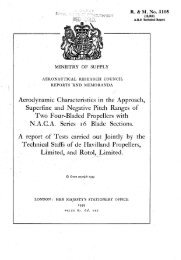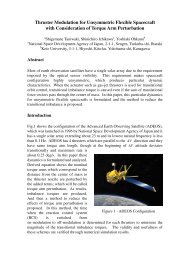The Prediction of Helicopter Rotor Hover Performance using a ...
The Prediction of Helicopter Rotor Hover Performance using a ...
The Prediction of Helicopter Rotor Hover Performance using a ...
Create successful ePaper yourself
Turn your PDF publications into a flip-book with our unique Google optimized e-Paper software.
<strong>The</strong> thrust and torque coefficients for the main rotor measured in flight<br />
9 . .<br />
by Brotherhood are compared with the theory in Fig.5. <strong>The</strong> experimental results<br />
were obtained on three different days with the rotor thrust coefficient varied<br />
mainly by changing the altitude <strong>of</strong> the aircraft. <strong>The</strong> theoretical results were<br />
also calculated by altering the density altitude and are shown with and without<br />
a vertical drag correction. If vertical drag is assumed to be 4% <strong>of</strong> the rotor<br />
thrust at low thrust increasing in proportion to the square <strong>of</strong> the mean value<br />
<strong>of</strong> downwash velocity at higher thrust levels, then excellent agreement between<br />
theory and experiment is obtained.<br />
Another Wessex helicopter at RAE Bedford was used to compare the perfor<br />
mance in flight <strong>of</strong> the new RAE (NPL) 9615 aer<strong>of</strong>oil section designed for the<br />
Lynx helicopter, with the standard NACA 0012 pr<strong>of</strong>ile. Two opposite blades were<br />
fitted with balsa wood and fibre glass fairings or gloves over the outer 12%<br />
<strong>of</strong> the blade, one glove shaped to the NACA 0012 section, the other to the new<br />
pr<strong>of</strong>ile. <strong>The</strong> chord length <strong>of</strong> the gloves was increased to 0.47 m to retain the<br />
correct thickness/chord ratio <strong>of</strong> the aer<strong>of</strong>oils. Pressure tubes connected to<br />
tappings in the gloves were led along the blade to a scanivalve mounted on top<br />
<strong>of</strong> the rotor hub. <strong>The</strong> drag <strong>of</strong> the aer<strong>of</strong>oils was also measured at two radial<br />
stations by rakes fitted behind the trailing edge <strong>of</strong> the blades. <strong>The</strong> time<br />
averaged pressures measured at four radial positions on each <strong>of</strong> the blades were<br />
integrated to give the aer<strong>of</strong>oil lift coefficient and the blade load.<br />
<strong>The</strong> load distribution on a helicopter blade is very difficult to measure<br />
in true hovering flight. A small amount <strong>of</strong> cyclic pitch will always be present<br />
to keep the aircraft in trim, and a slight wind will distort the path <strong>of</strong> the tip<br />
vortices and give asymmetric loading which itself changes the structure <strong>of</strong> the<br />
wake''. In the RAE tests, a few pressure transducers were also mounted in one<br />
<strong>of</strong> the gloves to give instantaneous pressures near the leading and trailing<br />
edge <strong>of</strong> the blade, and these show large variations, with azimuth, in local<br />
incidence near the tip. In some cases the loading was almost doubled and the<br />
aer<strong>of</strong>oil was operating for some <strong>of</strong> the time beyond the steady state stall<br />
boundary. Riley 10 has developed a simple analysis to estimate the change in<br />
the blade angle <strong>of</strong> incidence that occurs when the tip vortex is displaced from<br />
its expected position by a light wind. <strong>The</strong> analysis predicts the change in<br />
the angle <strong>of</strong> incidence quite well, and one example, <strong>using</strong> a wind speed <strong>of</strong> only<br />
2.5 m/s showed a positive increase in incidence for over 280 <strong>of</strong> the disc with<br />
an increase <strong>of</strong> over 2 near the 90° azimuth position. Thus the blade load<br />
19



